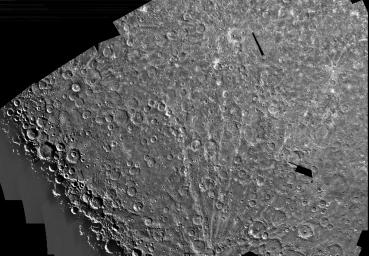
|
Mercury: Photomosaic of the Michelangelo Quadrangle H-12
- Click the image above for a larger view
- Full-Res JPEG (7200 x 5000) (6.1 MB)
- Full-Res TIFF (7200 x 5000) (33.5 MB)
Caption:
The Michelangelo Quadrangle, which lies in Mercury's southern polar region, was named in memory of the famous Italian artist. The Mercurian surface is heavily marred by numerous impact craters. Ejecta deposits, seen as bright lines or rays, radiate outward from the point of impact, along the planet's surface indicating the source craters are young topographical features. The rays found on Mercury are similar to ones found on the surface of Earth's moon.
Several large lobate scarps, steep and long escarpments which usually show a largely lobate outline on a scale of a few to tens of kilometers, are clearly visible in the lower left side of the image slicing through a variety of terrains including several large impact craters.
The Image Processing Lab at NASA's Jet Propulsion Laboratory produced this photomosaic using computer software and techniques developed for use in processing planetary data. The images used to construct the Michelangelo Quadrangle were taken during Mariner 10's second flyby of Mercury.
Background Info:
The Mariner 10 spacecraft was launched in 1974. The spacecraft took images of Venus in February 1974 on the way to three encounters with Mercury in March and September 1974 and March 1975. The spacecraft took more than 7,000 images of Mercury, Venus, the Earth and the Moon during its mission. The Mariner 10 Mission was managed by the Jet Propulsion Laboratory for NASA's Office of Space Science in Washington, D.C.
Cataloging Keywords:
| Name | Value | Additional Values |
|---|---|---|
| Target | Mercury | |
| System | ||
| Target Type | Planet | |
| Mission | Mariner | |
| Instrument Host | Mariner 10 | |
| Host Type | Flyby Spacecraft | |
| Instrument | ||
| Detector | ||
| Extra Keywords | Artwork, Crater, Grayscale, Impact | |
| Acquisition Date | ||
| Release Date | 2000-01-26 | |
| Date in Caption | ||
| Image Credit | NASA/JPL | |
| Source | photojournal.jpl.nasa.gov/catalog/PIA02237 | |
| Identifier | PIA02237 | |
